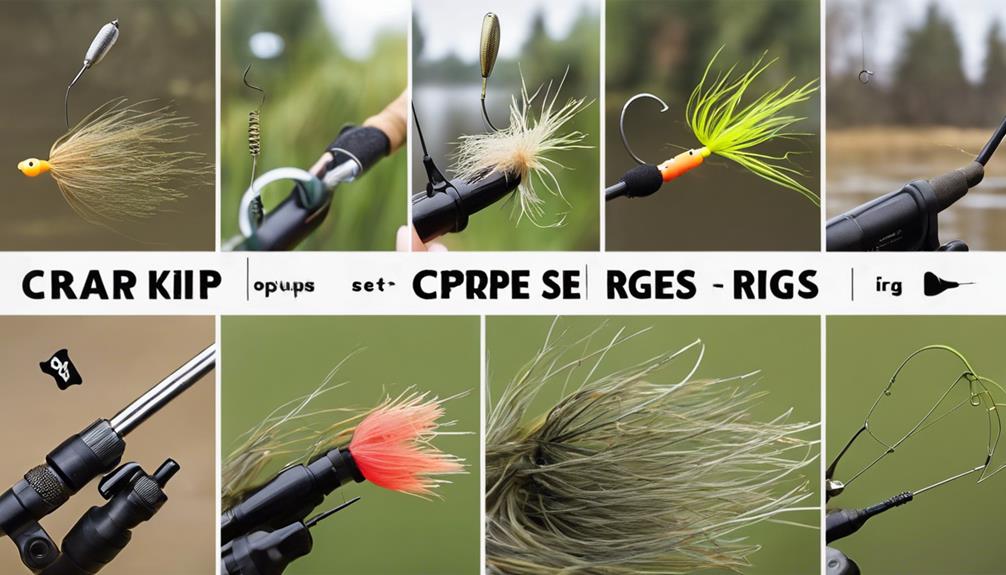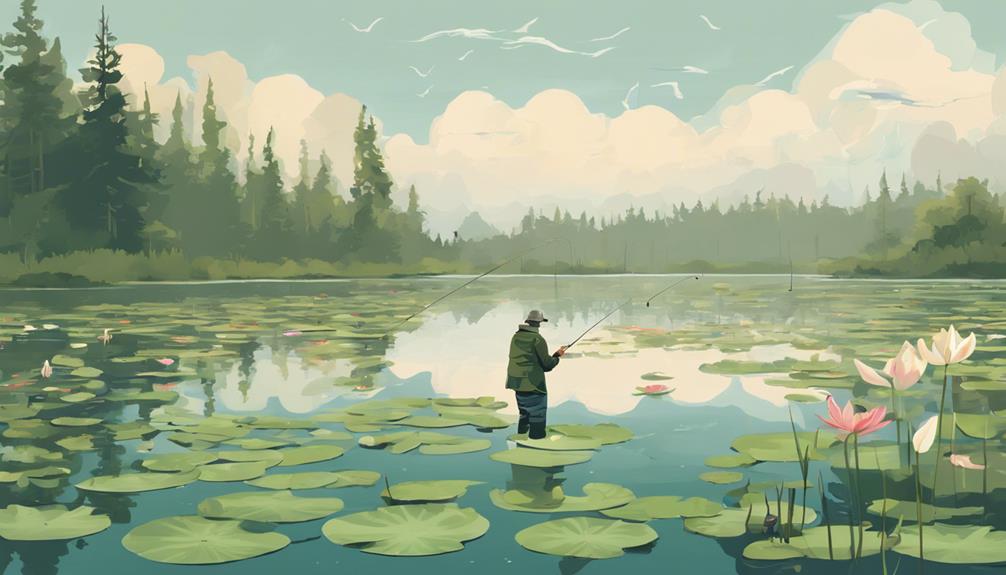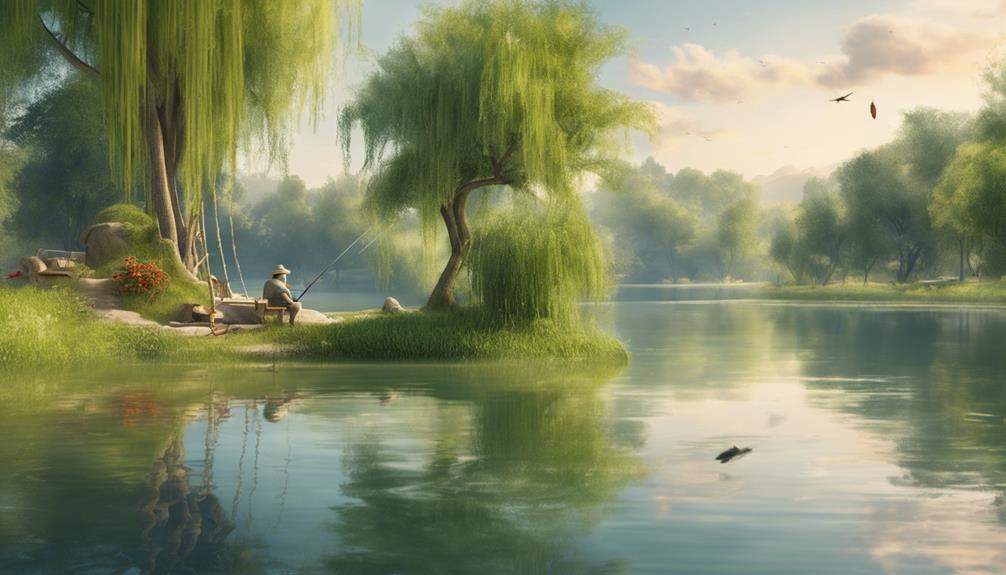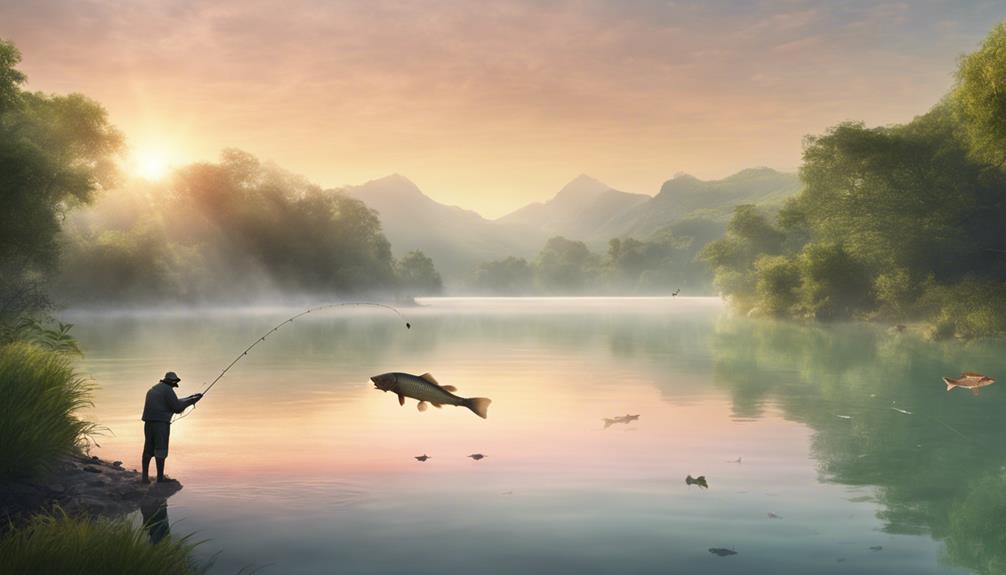Crafting successful strategies for carp fishing requires attention to details. Prepare your tackle meticulously based on location and water temperature. Seek out underwater structures and choose baits that attract carp with scents and colors they prefer. Select sturdy gear like braided lines for strength. Understand carp behavior to adapt your approach and refine your techniques. Stay mentally strong, work on your casting accuracy, and manage your time efficiently. Consider hook size and line strength matching carp size. Handle and release carp responsibly to contribute to conservation. Your commitment to these strategies will increase your chances of catching that prized carp.
Location Matters
When targeting carp, your success hinges greatly on finding the right location. Tackle preparation is crucial, but it's equally important to understand the impact of water temperature on carp behavior. To maximize your chances of a successful fishing trip, it's essential to consider these factors when selecting the perfect spot.
Tackle preparation sets the stage for a fruitful fishing experience, but without being in the right place, your efforts might go unrewarded. Carp are known to be sensitive to water temperature, affecting their feeding habits. During colder months, carp tend to be less active, requiring you to adjust your approach accordingly. In warmer water, they're more likely to be actively feeding, presenting you with a prime opportunity to land a catch.
When scouting for the ideal location, pay attention to areas where the water temperature is optimal for carp activity. Shallow waters tend to warm up faster, attracting carp looking for comfortable environments. Look for features like underwater structures, overhanging trees, or reed beds that provide shelter and attract carp. These spots not only offer favorable water temperatures but also serve as feeding grounds for carp.
Bait Selection Tips
Optimizing your bait selection is a crucial aspect of carp fishing success, requiring careful consideration and strategic planning. To enhance your chances of landing that prized carp, here are some key tips to keep in mind:
- Presentation Techniques and Hook Selection: When choosing your bait, think about how it will be presented to the carp. Consider using hair rigs or pop-up rigs to present your bait effectively. Selecting the right hook size and style is also essential. For example, using a wide gape hook can improve your hook-up rate with carp.
- Scent Attraction and Color Preferences: Carp are known for their keen sense of smell, so incorporating scents that attract them can significantly increase your success. Popular choices include garlic, strawberry, and fish oil-based scents. Additionally, consider the color of your bait. Carp have been known to have color preferences, with bright colors like yellow and orange often being effective choices.
- Experimentation and Adaptation: Don't be afraid to try out different baits and see what works best in your fishing spot. Carp can be picky eaters, so being willing to adapt to their preferences can make a significant difference. Keep a variety of bait options in your tackle box to ensure you're prepared for any situation.
Gear Essentials
Consider outfitting yourself with the necessary gear to maximize your chances of landing a prized carp on your next fishing excursion. Tackle selection plays a crucial role in carp fishing success. Opt for sturdy rods, reels, and lines capable of handling the fight of a strong carp. Look for reels with smooth drag systems to prevent line breakage during the battle with these powerful fish. Braided lines are excellent for sensitivity and strength, helping you feel even the slightest nibble.
When it comes to fishing techniques, using the right gear can make all the difference. Equip yourself with a variety of weights and hooks to adapt to different conditions. For carp fishing, hair rigs are popular due to their effectiveness in hooking carp without the fish detecting the hook easily. Additionally, have a selection of boilies, pellets, and corn in your tackle box to entice carp with a diverse menu.
Understanding how to use your gear effectively is just as important as having the right equipment. Practice casting accurately to specific spots where carp are likely to feed. Patience is key in carp fishing, as these fish can be cautious feeders. By mastering your tackle selection and fishing techniques, you'll be well on your way to reeling in some impressive carp on your next angling adventure.
Understanding Carp Behavior
To truly master carp fishing, understanding the behavior patterns of these elusive freshwater giants is essential. Carp are known for their unique feeding habits and intriguing spawning behavior, which can vary depending on the time of year and environmental conditions. Here are some key insights to help you gain a deeper understanding of carp behavior:
- Feeding Habits:
Carp are omnivorous bottom feeders, meaning they consume a wide variety of food sources from the lake or riverbed. They use their sensitive barbels to detect potential food items, such as insects, crustaceans, plants, and even small fish. Understanding what carp feed on can help you choose the right bait and improve your chances of a successful catch.
- Spawning Behavior:
Carp typically spawn in the spring when the water temperature reaches around 68-75°F (20-24°C). During this time, male carp will chase female carp in a frenzied manner, often creating splashes and disturbances on the water's surface. Knowing when and where carp are likely to spawn can guide your fishing efforts and help you target active fish.
- Behavioral Patterns:
Carp are cautious creatures and can exhibit shy behavior, especially in heavily fished waters. They're sensitive to vibrations and disturbances, so approaching your fishing spot quietly and using stealthy tactics can increase your chances of enticing a bite. By observing carp behavior closely, you can adapt your strategies to outsmart these crafty fish and enjoy a successful fishing session.
Weather Conditions Impact
When assessing the impact of weather conditions on carp fishing success, understanding how factors such as temperature, pressure, and precipitation influence carp behavior is crucial. Water temperature plays a significant role in determining where carp will be located. In warmer months, carp tend to move to shallower waters, while in colder months, they may seek out deeper areas. Therefore, adjusting your tackle preparation according to the water temperature can greatly increase your chances of a successful catch.
Seasonal patterns also have a profound effect on carp behavior. During the spring, carp are more active as they prepare for spawning, making it an excellent time for fishing. In contrast, during the hot summer months, carp may become lethargic due to the high temperatures. Wind direction is another crucial factor to consider. Carp are known to follow the direction of the wind, as it brings them food carried by the current. Positioning yourself accordingly can lead to more bites.
To maximize your chances of success, it's essential to adapt your fishing techniques based on the prevailing weather conditions. By staying informed about changes in temperature, pressure, precipitation, and wind direction, you can tailor your approach to suit the behavior of carp in different conditions. Remember, being attuned to these weather influences can make all the difference in your carp fishing expeditions.
Patience and Persistence
As you wait by the waters, understanding that carp fishing demands unwavering patience and persistent dedication can elevate your success in reeling in these elusive creatures. To truly excel in this pursuit, you must hone your skills not only in technique refinement but also in mental strength and strategy development. Here's how you can master the art of patience and persistence in carp fishing:
- Strategy Development: Crafting a successful fishing strategy involves more than just throwing a line into the water. It requires careful observation of the carp's behavior, understanding their feeding patterns, and adapting your approach accordingly. By developing a solid strategy based on these factors, you increase your chances of a successful catch.
- Mental Strength: Carp fishing can test your patience like few other activities. It's essential to stay focused, positive, and resilient, even when hours pass without any action. Building mental strength will help you stay determined and motivated, increasing your perseverance when faced with challenges.
- Technique Refinement and Time Management: Refining your fishing techniques is crucial for success. Whether it's perfecting your casting accuracy or adjusting your bait presentation, constant improvement is key. Additionally, managing your time efficiently on the waters ensures you make the most out of every fishing session, maximizing your opportunities to hook that prized carp.
Rig Set-Up Techniques

Crafting the perfect rig set-up for carp fishing requires a meticulous approach that accounts for various factors to optimize your chances of a successful catch. When it comes to hook size, choosing the right one is crucial. For carp fishing, using a size 6 to 10 hook is generally recommended, but this can vary based on the bait you're using and the size of the carp in the water you're fishing. A smaller hook may be necessary for more cautious fish, while larger hooks can be suitable for bigger carp or when using larger baits.
In addition to hook size, your line strength plays a significant role in your rig set-up. It's essential to match your line strength to the size of the carp you're targeting. For most carp fishing situations, a line with a breaking strain of 10-15 lbs should suffice. However, if you're fishing in waters with larger or stronger carp, you may need to use a heavier line to prevent break-offs.
When setting up your rig, ensure that your hook is tied securely to the line using reliable knots like the Palomar or Uni knot. Test the strength of your knot before casting to avoid losing a potential catch. By paying attention to details like hook size and line strength, you can increase your chances of landing that prized carp.
Handling and Releasing Carp
To ensure the well-being of the carp you catch, handling and releasing them properly is crucial in maintaining the health of the fish population. Safe handling practices not only benefit individual fish but also contribute to conservation efforts, ensuring that future generations of anglers can enjoy the thrill of carp fishing.
Here are three essential tips for handling and releasing carp responsibly:
- Use a Landing Net: When landing a carp, always use a soft mesh landing net to support the fish's weight. Avoid lifting the carp by its mouth or gills, as this can cause serious injury. By cradling the carp in a landing net, you provide crucial support and minimize the risk of harm.
- Minimize Air Exposure: Carp are sensitive creatures, and prolonged exposure to air can stress them out. To safeguard their well-being, keep the carp in the water as much as possible. Prepare your unhooking mat, weighing equipment, and camera before lifting the fish out of the water to ensure a quick and smooth process.
- Handle with Care: When handling carp, wet your hands to protect their delicate slime coat. This coat is essential for their protection against infections and parasites. Support the fish gently but securely, avoiding excessive squeezing or rough handling. By treating each carp with respect and care, you contribute to the sustainability of carp populations for years to come.
Frequently Asked Questions
How Can I Attract More Carp to My Fishing Spot?
To attract more carp to your fishing spot, focus on the essentials. Choose a prime location that aligns with carp feeding habits. Pay attention to the weather conditions and water depth for optimal results.
By understanding what lures them in, you can craft a strategy that entices these elusive fish to your hook.
Be patient and observant, and soon you'll be reeling in more carp than you ever imagined.
What Is the Best Way to Keep My Bait Fresh?
To keep your bait fresh, focus on proper bait storage and preservation techniques. Store your bait in a cool, dry place to prevent it from spoiling quickly. Avoid exposing it to direct sunlight or high temperatures.
Consider using a bait cooler or insulated bag to maintain freshness. Additionally, using airtight containers or resealable bags can help keep your bait in top condition for longer periods.
Fresh bait equals more bites, so prioritize its care!
Are There Any Specific Colors That Carp Are Attracted To?
When it comes to color preferences and carp behavior, it's important to understand that carp are attracted to certain hues due to their visual cues. Reds, oranges, and yellows tend to stand out underwater, catching the attention of these fish.
Incorporating these colors into your bait selection can increase your chances of a successful catch. By being mindful of the colors that carp are naturally drawn to, you can craft a strategy that maximizes your fishing experience.
Should I Use Scents to Enhance My Bait's Effectiveness?
You should definitely consider using scents to enhance your bait's effectiveness. Scent experiments have shown that carp are more likely to be attracted to baits with added scents. It can make a significant difference in getting bites.
When using scents, remember to store your bait properly to preserve the scent. Keep your bait in a cool, dry place and avoid exposure to strong odors that could mask the scent you're trying to attract the carp with.
What Is the Optimal Time of Day to Catch Carp?
For catching carp, the optimal time of day is early morning or late afternoon. During these times, carp are more active and feeding.
Night fishing can also be productive, especially during the full moon when carp are more active. By being on the water during these peak times, you increase your chances of a successful catch.
Try adjusting your fishing schedule to align with these prime feeding times to maximize your chances of success.
Conclusion
Now that you have mastered the art of crafting successful strategies for carp fishing, it's time to hit the water with confidence and skill.
Remember, location, bait selection, gear, understanding carp behavior, weather conditions, patience, and rig set-up are all crucial components to a successful trip.
With dedication and practice, you'll soon become a carp fishing pro, reeling in those big beauties with ease.
Happy fishing and tight lines!



